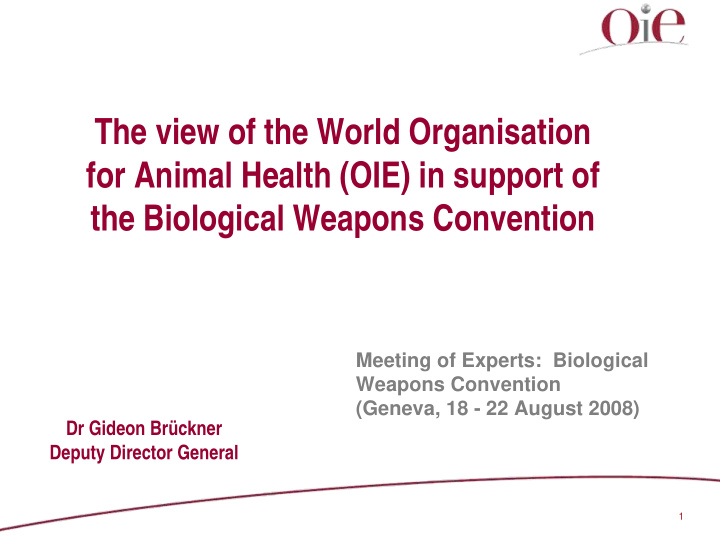



The view of the World Organisation for Animal Health (OIE) in support of the Biological Weapons Convention Meeting of Experts: Biological Weapons Convention (Geneva, 18 - 22 August 2008) Dr Gideon Brückner Deputy Director General 1
World Organization for Animal Health (1924) 172 Member Countries ( 2008) • Five permanent Regional Representations: Bamako, Buenos Aires, Tokyo, Sofia and Beirut • Two Sub-regional Offices: Bangkok, Gaborone • Five Regional Commissions: Africa, America, Asia- Pacific, Europe and Middle East 49 13 29 26 50 2
Why are OIE and FAO worried about the prevention and control of major animal diseases threats, biosecurity risks and zoonosis - including agroterrorism? 3
Zoonotic potential of animal pathogens 60% of human pathogens are zoonotic 80% of animal pathogens are multi-host 75% of emerging diseases are zoonotic 80% of agents having a potential bioterrorist use are zoonotic pathogens Nearly all new human diseases originate from animal reservoirs Diseases can now spread faster across the world than the average incubation period of most diseases 4
5 Our ENEMIES Our ENEMIES
Annual Global Trade in Exotic Animals � 4 million birds � 640,000 reptiles � 40,000 primates � Illegal trade unknown – estimate $4-6 billion 6
7 Emerging and Re-emerging Infectious Diseases
Factors of emergence and re-emergence 77% International travel and commerce 70% G lobalization of agriculture and trade 66% M icrobial adaptation 57% C limate and weather 49% C hanging ecosystems 43% C hanging host susceptibility 38% P overty 32% E conomic development 20% Technology 18% Intent to harm 8
Evolution of the OIE mandate Historical: ‘To prevent animal diseases from spreading around the world’ The 4th Strategic Plan 2006/2010 extends the OIE’s global mandate to: ‘The improvement of animal health all around the world’ 9
Underlying approach is to control/prevent the disease/threat at the animal source Animal health Good Veterinary governance Human health Animal Diseases Zoonosis Agroterrorism Poverty Creating Food security the buffer Lack of trade 10
OIE-PVS TOOL OIE methodology for the evaluation of the performance of veterinary services – including biosecurity applications in field and veterinary laboratories 11
OIE PVS Evaluations Country PVS Confidenti OIE OIE Regions Requests Missions ality Members received done Release 51 36 31 15 Africa 29 12 9 3 Americas 28 13 9 5 Asia & Pacific 51 9 8 4 Europe 13 10 5 1 Middle East 172 80 62 28 Total 12
OIE and the BWC • OIE in support of BWC • Global surveillance and preparedness • Inclusion of non-domestic animals (wild animals) • Animal diseases including zoonosis • Adherence to international animal health standards • Good veterinary governance 13
14 >200 RLs and OIE Reference Laboratories CC’s
Acceleration due to the Avian Influenza Crisis Global Early Crisis Management Warning System Center 15
Early Warning • Disease Alerts • Disease Alerts • Trends analysis • Trends analysis • Forecasting • Forecasting • Modeling • Modeling • Prediction • Prediction 16
I nternational standards, guidelines and recommendations Terrestrial Animal • Health Code Aquatic Animal Health • Code Manual of Diagnostic • Tests and Vaccines for Terrestrial Animals Manual of Diagnostic • Tests for Aquatic Animals 17
Biosecurity and biosafety • International standards for veterinary laboratories, vaccines, biocontainment • Together with FAO biosecurity guidelines for disease containment and introduction prevention • Expert group established in biotechnology to assess biosecurity risks on biotechnology for animal health • Expanded to biosecurity risks in food processing establishments (abattoirs) 18
The OIE provides Standards for containment facilities, procedures for safely handling infectious agents and guidelines for securing high risk pathogens 19
Terrestrial Animal Health Code provides: • Procedures for assessing the risk of infectious agents and criteria for grouping the agents into one of four risk groups • Details of the facility requirements for four containment levels • Facility standards to prevent the release of the agents into the environment and protect the laboratory workers 20
OIE Manual Manual of Diagnostic Tests and Vaccines for Terrestrial Animals provides: • the biosafety procedures to minimise the risk of infection of laboratory workers. It provides additions precautions for risk group 2, 3, and 4 agents. 21
Biosecurity - - Import control Import control Biosecurity • Biosecurity • Biosecurity involves the management involves the management of biological risks in a comprehensive of biological risks in a comprehensive manner to protect animal and plant life, manner to protect animal and plant life, health and protect the environment health and protect the environment • Prevent introduction of alien or • Prevent introduction of alien or undesirable species undesirable species • Import of biological material usually • Import of biological material usually requires an import permit requires an import permit 22
23
Risk convergence model Physical Environmental Genetic Factors and Biological Microbe Factors Human Social, Political Ecological and Economic Factors Factors Convergence Model (Microbial Threats to Health – IOM/NAS, 2003) 24
4 components of import risk analysis (Section 1.3 of the Code) Hazard Risk Risk Assessment Identification Management Risk Communication 25
Conclusion … Ensuring good governance to address emerging and re-emerging animal disease, biosecurity risk and bio-terrorist threats 26
Thank you very much! World Organisation for Animal Health 12 rue de Prony 75017 Paris, France Tel: 33 (0)1 44 15 18 88 – Fax: 33 (0)1 42 67 09 87 Email: oie@oie.int http:/ / www.oie.int 27
Recommend
More recommend